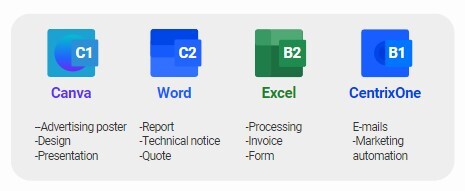However, even if you can write and read any line of code with ease, writing an IT resume is a whole other ballgame. Our IT recruiters in Montreal can help! Your biggest mission: to showcase your IT skills. Let's see how.
Who reads IT CVs?
The first legitimate question is: who will be looking at your CV? Well, depending on the size and structure of the company, the resume can fall into the hands of different people... But in general, it follows a very precise path in 2 steps.
The HR department screens CVs
Human Resources will probably be the first department to receive your resume. HR staff will screen it for specific keywords related to the job description. You should try to repeat the terms IT recruiters are looking for 4 to 5 times in his CV.
For example, if you are applying for a job in technology infrastructure, you will improve your chances if you can highlight the term without being overly repetitive.
The team manager verifies the candidates’ IT skills
CVs that make it through the HR department will most likely go to the team manager, who will assess whether the candidates have the required expertise. You will need to showcase the technology you are most familiar with and the projects you have worked on so far to convince the team manager that you are a good candidate.
To do this, you must be able to list your IT skills on your resume!
Which IT computer skills should you display on your resume?
Before listing all of your IT skills on your resume, you should be aware that not all of them are worthwhile. It's crucial to tailor your CV to the specific IT job offer you're pursuing, as each job offer will have its own set of requirements. Adapting your CV and highlighting the IT skills that match the company's needs will help you present a more fitting profile.
For instance, if you're applying for a full-stack Java developer position, you wouldn't necessarily need to list your knowledge of Adobe Photoshop…
However, there are some computer skills that may be useful for you to mention, such as:
- Computer languages: programming languages like Java, HTML/CSS, Python, PHP, and others.
- Marketing tools: Google Adwords, Mailchimp, and Google Analytics are digital marketing tools that can be advantageous for certain positions.
- Editing software: proficiency with Adobe Photoshop, Illustrator, or Canva can be valuable for graphic design roles.
- Extensive use of social media: if you're proficient in Facebook Business, Hootsuite, Instagram, or other social networks, highlighting your skills can demonstrate your professionalism.
- Office tools: The Office pack with Word, Excel, has intricacies and its software can be manipulated to a great extent. Mentioning them with your level is essential for any office job.
5 tips for knowing what IT skills your company is looking for
Take the time to do your research. You can use the following 5 steps to get a good feel for the most in-demand IT skills for the position:
- Read the job description;
- Research the company's website;
- Research their LinkedIn profile;
- If you are unsure about the occupation, research general information about it;
- Analyze similar job openings and their requirements.
Now that you know which computer skills should be on your resume and which ones you have, you will have a better chance of convincing recruiters.
However, is it necessary to include all of them in your IT resume? Ideally, your IT skills should be divided into a list of 6 to 10 points. Once again, it all depends on the position in question, the experience and the versatility required...
How to list IT skills on resume – 5 Tips
To effectively showcase your computer skills on your resume, it's important to consider various factors. This includes not only where to place them on your resume but also how to expand on them to strengthen your job application.
1. Create a dedicated section
To ensure that your computer skills are clearly emphasized, create a dedicated section on your resume specifically for "Computer Skills" or "Technical Skills." This will enable potential employers to quickly identify the skills you possess.
You can place this section at the top of your resume or on the side as a margin. Alternatively, you can integrate it with your work experience section to demonstrate how each experience has contributed to your skill set.
2. Prioritize your skills based on relevance
Rank your skills in order of relevance, starting with the most important skills for the position you are applying for.
For instance, if the job requires Java programming skills, list Java at the top of your skills list. By doing this, you can capture the recruiter's attention and showcase your suitability for the job.
3. Be specific
Instead of using generic terms like "computer skills," mention the programming languages, software, or systems that you are proficient in. For instance, list specific skills like Java, SQL, Photoshop, Windows, Linux, etc.
Additionally, if you have expertise in Microsoft or the Office package, specify your proficiency level to distinguish yourself from other candidates, because everyone uses those tools.
4. Indicate your proficiency level
Whether you are an expert or a beginner, it's important to indicate your level of proficiency in each skill you list on your resume.
You can use an appropriate design, such as a slider or barometer, to convey your proficiency level more effectively.
5. Highlight your accomplishments
If you have worked on major IT projects, be sure to include them in your resume and describe your role and accomplishments. This will demonstrate your practical skills and experience.
Use specific numbers and results, whenever possible, to show the impact of your work. For instance, highlight achievements like "I optimized the code, resulting in a 50% increase in data processing speed." Additionally, if you have earned any IT certifications, mention them in your resume.
IT computer skills on a resume: examples
Prefer concise information rather than a simple mention of your skills.
Thus, the mention of Word or Excel, used by many candidates, can be enhanced with details, and even an icon to enhance the appearance of the CV.
In the example of this IT resume, the person used Word to produce reports, technical notices or quotes.

If you mention specific expertise in computer languages, as in the example of this resume of a full stack Java developer, the use of sliders with the mention of known languages is a good thing. You can also provide details on the technical environment in which you have evolved.
Here, the back and the front have been dissociated for more clarity.

Finally, for an example of computer skills for a digital marketing organic SEO expert resume, splitting their skills into categories helps break up the information.

If you are a recent graduate or if you want to switch to IT and have no experience, our article How to make a resume without work experience will help you.
Our last 2 bonus tips for successful IT resume writing
The recruitment experts at Fed IT have reviewed countless resumes throughout their careers, and it's no secret that it can be challenging to make your application stand out from the rest. Even the slightest mistake can be detrimental. When it comes to writing a CV, there are two critical criteria that you must keep in mind, regardless of the job offer you're applying for:
- Structure your CV for clarity;
- Keep information concise and to the point.
1. Structure your resume for clarity
Once you have identified the relevant information, you must organize your resume. The goal here is not to create a visually stunning document.
Instead, focus on building a clean, easy-to-read CV with clear headings, bullet points, and a single font. The structure should be straightforward and visually appealing.
2. Keep information concise and to the point
Even if you possess numerous skills and have participated in various projects or competitions, it's crucial to be concise. Your CV should not exceed two pages, which can be challenging for experienced candidates.
To the point, select the details that are most relevant to the job description. Tailor your CV to the position by eliminating any irrelevant information. This ensures that your IT skills and accomplishments are pertinent to the job.
Remember, your CV is simply a tool to get an IT job interview. Any information that you intentionally leave out may appear on your LinkedIn profile or personal website. Don't worry, recruiters know how to obtain additional information if necessary! 😊
Write a great IT CV for IT jobs in Montreal
By following these tips, you will be able to write a computer resume that stands out from the crowd. Then, it's up to you to continue this excellent work during the interview, the key moment when you will meet the recruiter.
To find out more about temporary and permanent recruitment for IT jobs, consult the news section of our website or contact us! You can also submit a spontaneous application if you haven't found what you're looking for among our job offers.




